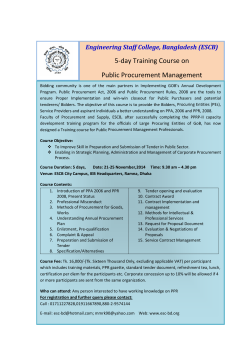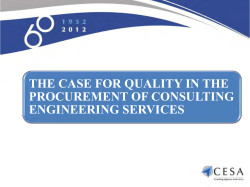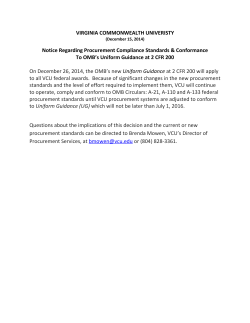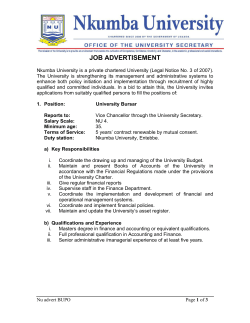
Order Instituting Rulemaking to Continue Implementation and
Decision _____________ BEFORE THE PUBLIC UTILITIES COMMISSION OF THE STATE OF CALIFORNIA Order Instituting Rulemaking to Continue Implementation and Administration of California Renewables Portfolio Standard Program. Rulemaking 11-05-005 (Filed May 5, 2011) INTERVENOR COMPENSATION CLAIM OF THE UNION OF CONCERNED SCIENTISTS (UCS) AND DECISION ON INTERVENOR COMPENSATION CLAIM OF THE UNION OF CONCERNED SCIENTISTS (UCS) Intervenor: UCS For contribution to Decision (D.)14-11-042 Claimed: $13,630.10 Awarded: $ Assigned Commissioner: Carla Peterman Assigned ALJ: Anne E. Simon and Regina DeAngelis I hereby certify that the information I have set forth in Parts I, II, and III of this Claim is true to my best knowledge, information and belief. I further certify that, in conformance with the Rules of Practice and Procedure, this Claim has been served this day upon all required persons (as set forth in the Certificate of Service attached as Attachment 1). Signature: Date: 1/23/2015 Printed Name: Laura Wisland PART I: PROCEDURAL ISSUES (to be completed by Intervenor except where indicated) A. Brief description of Decision: This decision conditionally accepts the 2014 RPS procurement plans. This decision also adopts certain revisions to the RPS procurement process, and how the Commission-approved Renewable Net Short (RNS) methodology is to be used in the RPS procurement process. In addition, this decision adopts an interim renewable integration adder and a method for handling resource adequacy valuation in the RPS procurement process. B. Intervenor must satisfy intervenor compensation requirements set forth in Pub. Util. Code §§ 1801-1812: Intervenor CPUC Verified Timely filing of notice of intent to claim compensation (NOI) (§ 1804(a)): N/A 1. Date of Prehearing Conference (PHC): 2. Other specified date for NOI: On 5/10/2011, an OIR was issued in R.11-05-005 requesting parties to file an updated NOI. 6/6/2011 3. Date NOI filed: 4. Was the NOI timely filed? Showing of customer or customer-related status (§ 1802(b)): 5. Based on ALJ ruling issued in proceeding number: R.06-02-012 6. Date of ALJ ruling: 9/14/2006 7. Based on another CPUC determination (specify): N/A On September 14, 2006, an ALJ ruling was issued in the precursor proceeding to R.11-05-005, R.06-02-012, that found UCS eligible to receive intervenor compensation, and also found UCS to be a “Category 3” customer meeting the standard of significant financial hardship within the meaning and definition of Public Utilities (P.U.) Code Sections 1802(b)(1)(C) and 1802(g). UCS’s circumstances with respect to eligibility have not changed. 8. Has the Intervenor demonstrated customer or customer-related status? Showing of “significant financial hardship” (§ 1802(g)): 9. Based on ALJ ruling issued in proceeding number: R.06-02-012 (see UCS’s response to Question 5) 10. Date of ALJ ruling: 9/14/2006 (see UCS’s response to Question 5) 11. Based on another CPUC determination (specify): N/A . 12. Has the Intervenor demonstrated significant financial hardship? Timely request for compensation (§ 1804(c)): 13. Identify Final Decision: D.14-11-042 14. Date of issuance of Final Order or Decision: 11/24/2014 15. File date of compensation request: 1/23/2015 16. Was the request for compensation timely? C. Additional Comments on Part I (use line reference # as appropriate): # Intervenor’s Comment(s) CPUC Discussion In this compensation request, UCS includes work that directly contributed to the final adoption of a Renewable Net Short (RNS) methodology, which was included in the ALJ’s Ruling on RNS, issued on May 21, 2014. This work directly contributes to D.14-11-042 because D.14-11-042 requires that the revised RNS methodology be applied in the 2014 RPS procurement plans for the first time. (See D.14-11-042, pp.8-9). PART II: SUBSTANTIAL CONTRIBUTION (to be completed by Intervenor except where indicated) A. Did the Intervenor substantially contribute to the final decision (see § 1802(i), § 1803(a), and D.98-04-059). (For each contribution, support with specific reference to the record.) Intervenor’s Claimed Contribution(s) 1. RNS methodology – voluntary procurement and AB 327 authority: The Commission’s Feb. 19, Specific References to Intervenor’s Claimed Contribution(s) “VMOP in the Revised RNS methodology does not limit the Commission’s authority to increase RPS PQRs pursuant to Assembly Bill (AB) CPUC Discussion 2014 Ruling included a Renewable Net Short (RNS) staff proposal that asked parties to comment on how the passage of AB 327 changed the ability of retail sellers to voluntarily procure renewables beyond their Procurement Quantity Requirement (PQR), and whether the Commission should place a quantitative limit on voluntary procurement. UCS advocated to not place a quantitative limit on voluntary procurement, and argued that statutory changes made by AB 327 did not reduce the ability of retail sellers to voluntarily procure renewables beyond the PQR. The resulting May 21st Ruling adopted criteria for addressing voluntary procurement that were consistent with UCS’s comments. In addition, D.1411-042 affirms the right of retail sellers to voluntarily procure renewables beyond the PQR. 327 nor a retail seller’s ability to propose voluntary RPS procurement above its PQR.” May 21 Ruling on RNS, pp.11-12. “For the 2014 RPS Procurement Plans, the ALJ issued a ruling on May 21, 2014 with a revised RNS to reflect changes recommended by the Energy Division, after receipt of comments. The May 21, 2014 ruling requests the utilities and ESPs to use the revised RNS methodology for calculating the RNS for purposes of their 2014 RPS Procurement Plans.” D.14-11-042, pp.89. “The IOUs do have the authority to request the permission of the Commission to procure amounts beyond the requirements set forth in the statute.” D.14-11-042, p.15. See UCS Opening Comments on 2/19 Ruling, March 12, 2014, pp. 3-5 and UCS/GPI Reply Comments on 2/19 Ruling, March 26, 2014, pp. 1-3. D.14-11-042 applies the May 21 RNS for the first time. “In an effort to update the RNS methodology to better reflect how retail sellers are likely to utilize their forecast The Feb. 19, 2014 RNS Ruling RECs above the PQR in future years, the revised RNS methodology requires also asked parties to comment on how forecasted procurement retail sellers to apply their optimization strategy for managing forecast RECs in excess of a retail seller’s above the PQR in their optimized RNS, PQR should impact the RNS which will be submitted and reviewed calculation. through a retail seller’s annual RPS Instead of requiring that retail plan.” May 21 Ruling on RNS, p.9. sellers apply excess procurement evenly over a 102. RNS methodology – allocation of excess procurement: year period (as suggested in the 2/19 RNS proposal) UCS advocated to allow the retail sellers to apply their own strategy for managing excess procurement to their RNS calculation, which would then be reviewed and accepted or rejected by the Commission. The resulting May 21 RNS methodology allowed retail sellers to optimize the use of excess procurement in their RNS calculations, consistent with UCS’s suggestion. “For the 2014 RPS Procurement Plans, the ALJ issued a ruling on May 21, 2014 with a revised RNS to reflect changes recommended by the Energy Division, after receipt of comments. The May 21, 2014 ruling requests the utilities and ESPs to use the revised RNS methodology for calculating the RNS for purposes of their 2014 RPS Procurement Plans.” D.14-11-042, pp.89. See UCS Opening Comments on 2/19 Ruling, March 12, 2014, pp. 2-3. D.14-11-042 applies the May 21 RNS for the first time. 3. RNS methodology – RECs from expiring contracts: The Feb. 19, 2014 RNS Ruling also asked parties to comment on how RECs from expiring contracts should be handled in future RNS calculations. UCS supported the 2/19 staff proposal requirement to disclose the amount of RECs expiring in their RNS filings. UCS also advocated that retail sellers disclose the technology type of these contracts, a suggestion that the Commission did not adopt. The resulting May 21 RNS methodology requires retail sellers to discuss the amounts of expiring contracts in RNS filings, consistent with UCS’s position. “To account for the possibility of retail sellers re-contracting with these existing RPS facilities, Staff requires that retail sellers disclose RECs from Expiring Contracts in their RNS filings.” May 21 Ruling on RNS, p.18. “For the 2014 RPS Procurement Plans, the ALJ issued a ruling on May 21, 2014 with a revised RNS to reflect changes recommended by the Energy Division, after receipt of comments. The May 21, 2014 ruling requests the utilities and ESPs to use the revised RNS methodology for calculating the RNS for purposes of their 2014 RPS Procurement Plans.” D.14-11-042, pp.89. See UCS Opening Comments on 2/19 Ruling, March 12, 2014, pp. 5-6. D.14-11-042 applies the May 21 RNS for the first time. 4. Resource Adequacy “In today’s decision, we decline to valuation in RPS methodology: The Commission’s March 26, 2014 ACR proposed to value resource adequacy at zero in the utilities’ least-cost best-fit (LCBF) methodologies for the 2014 RPS procurement plans. UCS advocated that the Commission assume a positive value to RA in the LCBF methodologies. D.14-11-042 declined to adopt the March 26, 2014 ACR suggestion. 5. Renewable Integration Cost Adder The Commission’s March 26, 2014 ACR asked parties to comment on whether and how the Commission should approve a renewable integration adder to be used in the LCBF methodologies for the 2014 RPS procurement plans. UCS’s opening and reply comments supported the development of a renewable integration adder and included detail on what should be counted in an adder. In particular, UCS advocated that the IOU’s take a uniform approach to an adder, and the adder must be updated to reflect the changing conditions of the grid. UCS also advocated against adopting an interim adder, and that instead an adder should be developed through a public process, in adopt the March 26, 2014 ACR proposal that resource adequacy be valued at zero in the utilities LCBF methodologies for their annual 2014 RPS solicitations.” “Other parties state that resource adequacy is a defined product with market value and that the lack of need for resource adequacy will be reflected in low resource adequacy values.” “We also agree with PG&E, SCE, and UCS that the lack of capacity need should be reflected in low resource adequacy values.” D.14-11-042, p. 49, 51 and 52. See UCS/Sierra Club/NRDC Reply Comments, July 30, 2014, pp.1-2. “To move this process forward, the Commission will consider the final methodology in coordination with R.1312-010, the Long-Term Procurement Planning proceeding, and any other proceeding that may be relevant to the future.” D.14-11-042, p.54 “Variable costs include: ancillary services costs for offsetting intra-hour variability (reg-up/down), Flexible ramping capacity costs for offsetting intra-hour forecast error, and flexible ramping capacity costs for meeting hour-by-hour and multi-hour capacity need.” D.14-11-042, p. 55. “The integration cost adders should be dependent on portfolio mix and system need and, as a result, must be updated regularly.”D.14-11-042, p. 56. “The record development for a final methodology is an on-going process and, as of today, is not sufficiently developed to provide a basis for a decision on a final methodology.”D.1411-042, p.57 “The process to consider a final close coordination with the long-term procurement planning (LTPP) proceeding. Although D.14-11-042 does adopt an interim adder, it contains many positions that are consistent with UCS’s comments. Specifically, D.1411-042 acknowledges the need for a more robust public process to develop a final methodology, the need to coordinate with the LTPP proceeding R.13-12-010, the need to update the adder periodically, and contains costs to be included in the adder that UCS suggested. 6. RPS Procurement Reform Process – data adequacy requirements The Commission’s Ruling issued April 8, 2014 contained a revised staff proposal to reform the RPS procurement process. It proposed that all PPAs include a set of environmental data to help the Commission better assess whether the proposed project is viable. UCS’s Opening comments cautioned against adopting these data requirements until the Commission clarify the intended benefit of each data category and provide staff with guidance if the data quality is sub-par. The only environmental data requirement UCS supported adopting was the requirement to include a GIS file of the project boundary. methodology may include hearings or workshops to be scheduled as soon as practicable. Additional written comments may also be requested.” D.14-11-042, p.64. See UCS Opening Comments, July 2, 2014, pp.1-4; UCS/Sierra Club/NRDC Reply Comments, July 30, 2014, pp.210. “In this decision, we adopt the Energy Division’s proposal for data adequacy requirements, but refrain, with one exception, from adopting the Energy Division’s proposal for specific data requirements related to the environmental data as we find these additional requirements not necessary at this time. We adopt the Energy Division’s proposal to require the utilities to provide the Commission with a Geographic Information System (GIS) file of the project boundaries and associated gen-tie for all projects that currently have an RPS PPA and for all future RPS bids submitted to an annual RPS solicitation or other RPS procurement programs.” D.14-11-042, pp.66-67. See UCS Opening Comments, May 7, 2014, pp.1-4. D.14-11-042 rejects all of the environmental data requirements except for the project boundary requirement. 7. RPS Procurement Reform Process – standards of review for IOU shortlists The Commission’s April 8, 2014 staff proposal included the suggestion that each PPA be analyzed for its consistency with the RNS before it be placed on the shortlist. UCS argued against this suggestion, pointing out that this could service to place a de facto cap on RPS procurement. “The Energy Division Proposal included additional suggestions, such as that the utilities publicly disclose and rank in their shortlist advice letter filings the bids and that the utilities provide renewable net short and LCBF analysis for each bid…We do not adopt these requirements.” D.14-11-042, pp.71-72. See UCS Opening Comments, November 20, 2012, pp.2-5; UCS Reply Comments, December 12, 2012, p.1-3; UCS Opening Comments, May 7, 2014, pp.4-8. This concept- that the utilities would be required to analyze each contract on whether it is “needed” when assessed against the RNS calculation, was also proposed in the Oct. 5, 2012 Second ACR Issuing Procurement Reform Proposals. UCS filed comments on November 20, 2012 and December 12, 2012 that urged the Commission to reject this requirement because it would create a de facto cap on RPS procurement. D.14-11-042 rejects the staff proposal’s suggestion. 8. RPS Procurement Reform Process – standards of review for IOU shortlists “The Energy Division also suggested that utilities be prohibited from entering into contracts until after the Commission approves the shortlist. We do not adopt these requirements.” D.14-11-042, pp.71-72. The Commission’s April 8, 2014 staff proposal also included the suggestion that the See UCS Opening Comments, May 7, utilities should be prohibited from signing contracts until after the Commission approves the shortlist. 2014, pp.8-9. UCS argued against this provision because the staff proposal suggested that one of the reasons to delay approval of the shortlist was inconsistency with the RNS calculation. UCS did not think this was a reasonable delay for holding up individual PPA negotiations. D.14-11-042 rejects the staff proposal’s suggestion. 9. RPS Procurement Reform Process – expedited review of shortterm contracts. The Commission’s Oct. 5, 2012 Second ACR Issuing Procurement Reform Proposals suggested an expedited process for contracts that are less than 5 years in length. “In today’s decision, we modify the current process for utilities to seek approval of a short-term contract (under 5 years) by authorizing the use of a Tier 1 Advice Letter, rather than a Tier 3 Advice Letter.” D.14-11-042, p.74. See UCS Opening Comments, Nov. 20, 2012, p.1-2. UCS supported this process and D.14-11-042 adopts it. 10. RPS Procurement Reform Process – Commission review of PA, bilateral contracts, contract amendments, and contracts for RECs. The Commission’s Oct. 5, 2012 Second ACR Issuing Procurement Reform Proposals suggested that certain contracts that were deemed to be “nonstandard” should be submitted to the Commission through an Application instead of the “Beyond adopting Standards of Review (also referred to as SOR), we refrain from adopting further aspects of this proposal.” D.14-11-042, p.78. See UCS Opening Comments, Nov. 20, 2012, pp.5-6; UCS Reply Comments, Dec. 12, 2012, pp.3-4. Advice Letter process. UCS’s comments on Nov. 20 and Dec. 12, 2012 argue against adopting this procedure because it will add an unfair amount of market uncertainty, discourage innovation, and increase project approval timelines. D.14-11-042 did not adopt this proposal. 11. RPS Procurement Reform Process – Commission review of PPAs, bilateral contracts, contract amendments, and contracts for RECs. The Commission’s Oct. 5, 2012 Second ACR Issuing Procurement Reform Proposals also asked parties to comment on whether the Commission should compare unbundled REC contracts to bundled procurement. “Beyond adopting Standards of Review (also referred to as SOR), we refrain from adopting further aspects of this proposal.” D.14-11-042, p.78. See UCS Opening Comments, Nov. 20, 2012, pp.6-7; UCS Reply Comments, Dec. 12, 2012, pp.4-5. UCS argued against this proposal because the statute treats bundled procurement and unbundled RECs differently, which means that these transactions will have different values. D.14-11-042 did not adopt this proposal. 12. RPS Procurement Reform Process – Commission review of PPAs, bilateral contracts, contract amendments, and contracts for RECs. The Commission’s Oct. 5, 2012 Second ACR Issuing Procurement Reform Proposals “Beyond adopting Standards of Review (also referred to as SOR), we refrain from adopting further aspects of this proposal.” D.14-11-042, p.78. See UCS Opening Comments, Nov. 20, 2012, pp.7-10; UCS Reply Comments, Dec. 12, 2012, pp.7-8. proposed to reform or entirely remove the non-modifiable Standard Term and Condition 2 (STC 2), which defines “green attributes” in RPS contracts. UCS argued against such modifications because it was not clear the value that such a change would provide, and such a change would create significant market uncertainty for REC purchasers. D.14-11-042 did not adopt this proposal. B. Duplication of Effort (§ 1801.3(f) and § 1802.5): Intervenor’s Assertion a. Was the Office of Ratepayer Advocates (ORA) a party to the proceeding?1 Yes b. Were there other parties to the proceeding with positions similar to yours? Yes. CPUC Discussion c. If so, provide name of other parties: The Green Power Institute, the Natural Resources Defense Council, and Sierra Club California were somewhat active in this proceeding on matters related to RPS procurement processes and the LCBF process. Defenders of Wildlife, the Nature Conservancy, and the Natural Resources Defense Council were also active in this proceeding regarding matters of environmental data adequacy. d. Intervenor’s claim of non-duplication: In conducting its work, UCS consistently coordinated its efforts in this proceeding with other parties as much as possible to avoid duplication of effort and to ensure efficiency. UCS cofiled comments on two occasions when there was significant overlap in positiononce with the GPI and once with Sierra Club California and NRDC. Any other duplication that occurred in this proceeding was unavoidable due to parties’ sometimes similar interests, and the overwhelming number and scope of issues addressed in the decision. C. Additional Comments on Part II (use line reference # or letter as appropriate): # 1 Intervenor’s Comment CPUC Discussion The Division of Ratepayer Advocates was renamed the Office of Ratepayer Advocates effective September 26, 2013, pursuant to Senate Bill No. 96 (Budget Act of 2013: public resources), which was approved by the Governor on September 26, 2013. n/a PART III: REASONABLENESS OF REQUESTED COMPENSATION (to be completed by Intervenor except where indicated) A. General Claim of Reasonableness (§ 1801 and § 1806): a. Intervenor’s claim of cost reasonableness: UCS requests a rate of compensation for hours spent in 2012 in accordance with the 2012 rate accepted for Laura Wisland in D.13-10-036. For 2013 rates, UCS applied a 2% COLA as authorized in Resolution ALJ287. For 2014 rates, UCS applied a 2.58% COLA as authorized in Resolution AJL-303. b. Reasonableness of hours claimed: UCS has maintained detailed records of time spent on this proceeding, which are provided in Attachment 2. UCS is seeking compensation for time spent by staff to develop the record for D.14-11-042 and prepare this intervenor compensation request. The hours claimed are reasonable given the scope of this proceeding and the complexity of the issues presented. No compensation for administrative time or local travel time is requested, in accordance with Commission practice. c. Allocation of hours by issue: UCS has allocated its hours associated with D.14-11-042 into the following categories: Issue A (36%): RPS procurement reform process: Time spent analyzing staff proposals, attending workshops, and preparing comments related to reforming the RPS procurement process. Issue B (37%): Renewable Net Short (RNS): Time spent analyzing staff proposals, attending workshops, and preparing comments related to methodology and application of the RNS to RPS procurement. Issue C (23%): RPS integration adder: Time spent analyzing staff proposals and preparing comments related to the development and implementation of an RPS integration adder, to use for RPS procurement. Issue D (5%): Resource adequacy valuation in RPS procurement: Time spent analyzing staff proposals and preparing comments related to how RA values should be treated in the LCBF process within RPS procurement. CPUC Discussion B. Specific Claim:* CLAIMED CPUC AWARD ATTORNEY, EXPERT, AND ADVOCATE FEES Item Basis for Rate* Total $ $140 D.13-10-036 $3,080.00 7 $142.80 D.13-10-036, Res. ALJ-287 $999.60 60.2 $146.48 D.13-10-036 Res. ALJ-303 $8,818.10 Year Hours Laura Wisland 2012 22 Laura Wisland 2013 Laura Wisland 2014 Rate $ Hours Subtotal: $ 12,897.70 Rate $ Total $ Subtotal: $ OTHER FEES Describe here what OTHER HOURLY FEES you are Claiming (paralegal, travel **, etc.): Item Year Hours n/a [Person 1] n/a Rate $ Basis for Rate* n/a Total $ n/a Hours Rate Total $ 0.00 Subtotal: $0.00 Subtotal: $ INTERVENOR COMPENSATION CLAIM PREPARATION ** Item Year Hours Rate $ Laura Wisland 2015 10 73.24 Basis for Rate* D.13-10-036 Res. ALJ-303 Total $ Hours Rate Total $ $732.40 Subtotal: $732.40 Subtotal: $ COSTS # Item n/a Detail n/a Amount Amount 0.00 TOTAL REQUEST: $13,630.10 TOTAL AWARD: $ **We remind all intervenors that Commission staff may audit their records related to the award and that intervenors must make and retain adequate accounting and other documentation to support all claims for intervenor compensation. Intervenor’s records should identify specific issues for which it seeks compensation, the actual time spent by each employee or consultant, the applicable hourly rates, fees paid to consultants and any other costs for which compensation was claimed. The records pertaining to an award of compensation shall be retained for at least three years from the date of the final decision making the award. **Travel and Reasonable Claim preparation time typically compensated at ½ of preparer’s normal hourly rate ATTORNEY INFORMATION Attorney Date Admitted to CA BAR2 Member Number Actions Affecting Eligibility (Yes/No?) If “Yes”, attach explanation n/a n/a n/a n/a C. Attachments Documenting Specific Claim and Comments on Part III (Intervenor completes; attachments not attached to final Decision): Attachment or Comment # Description/Comment 1 Certificate of Service 2 UCS Timesheets in R.11-05-005 related to D.14-11-042 D. CPUC Disallowances and Adjustments (CPUC completes): Item Reason PART IV: OPPOSITIONS AND COMMENTS Within 30 days after service of this Claim, Commission Staff or any other party may file a response to the Claim (see § 1804(c)) (CPUC completes the remainder of this form) A. Opposition: Did any party oppose the Claim? If so: Party 2 Reason for Opposition This information may be obtained through the State Bar of California’s website at http://members.calbar.ca.gov/fal/MemberSearch/QuickSearch . CPUC Discussion B. Comment Period: Was the 30-day comment period waived (see Rule 14.6(c)(6))? If not: Party Comment CPUC Discussion FINDINGS OF FACT 1. Intervenor [has/has not] made a substantial contribution to D._________. 2. The requested hourly rates for Intervenor’s representatives [,as adjusted herein,] are comparable to market rates paid to experts and advocates having comparable training and experience and offering similar services. 3. The claimed costs and expenses [,as adjusted herein,] are reasonable and commensurate with the work performed. 4. The total of reasonable compensation is $___________. CONCLUSION OF LAW 1. The Claim, with any adjustment set forth above, [satisfies/fails to satisfy] all requirements of Pub. Util. Code §§ 1801-1812. ORDER 1. Intervenor is awarded $____________. 2. Within 30 days of the effective date of this decision, _____ shall pay Intervenor the total award. [for multiple utilities: “Within 30 days of the effective date of this decision, ^, ^, and ^ shall pay Intervenor their respective shares of the award, based on their California-jurisdictional [industry type, for example, electric] revenues for the ^ calendar year, to reflect the year in which the proceeding was primarily litigated.”] Payment of the award shall include compound interest at the rate earned on prime, three-month non-financial commercial paper as reported in Federal Reserve Statistical Release H.15, beginning [date], the 75th day after the filing of Intervenor’s request, and continuing until full payment is made. 3. The comment period for today’s decision [is/is not] waived. 4. This decision is effective today. Dated _____________, at San Francisco, California.
© Copyright 2025








